Cyprinodon
| Cyprinodon | |
|---|---|
.jpg) | |
| Cyprinodon radiosus | |
| Scientific classification | |
| Kingdom: | Animalia |
| Phylum: | Chordata |
| Class: | Actinopterygii |
| Order: | Cyprinodontiformes |
| Family: | Cyprinodontidae |
| Subfamily: | Cyprinodontinae |
| Genus: | Cyprinodon Lacépède, 1803 |
| Type species | |
| Cyprinodon variegatus Lacépède, 1803 | |
| Synonyms | |
| |
Cyprinodon is a genus of small pupfishes found in fresh, brackish and salt water. The genus is primarily found in Mexico, the Caribbean Islands and southern United States (Arizona, California, Florida, Nevada, New Mexico, Oklahoma and Texas), but C. variegatus occurs as far north as Massachusetts and along the entire Gulf of Mexico coastline, and C. dearborni and C. variegatus are found in northern South America.[1][2] Many species have tiny ranges and are highly threatened, in some cases already extinct.[2][3] Cyprinodon are small; the largest reaches 10 cm (3.9 in) in length and most other species only reach about half that.[1]
Distribution and habitat
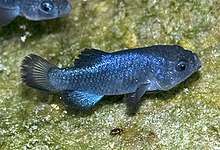
A few Cyprinodon species have quite large ranges, notably C. variegatus, but the vast majority have small ranges, typically restricted to one or two Mexican states or US states, Hispaniola, or a Bahaman island. C. longidorsalis and C. diabolis have both been said to have the smallest native range of any vertebrate species, with the former being restricted to a spring pool that covers about 10 m2 (110 sq ft) and the latter to an 18 m2 (190 sq ft) shelf in a spring pool, but C. longidorsalis is now only found in captivity as its habitat has disappeared.[3][4] While most Cyprinodon species have separate distributions, seven (C. beltrani, C. esconditus, C. labiosus, C. maya, C. simus, C. suavium and C. verecundus) are endemic in Lake Chichancanab in Quintana Roo, Mexico,[5][6] and three (the endemic C. brontotheroides and C. desquamator, and the widespread C. variegatus) live in the hypersaline lakes on San Salvador Island in the Bahamas.[2] In a few other cases separate species do come into contact towards the edges of their distributions where they often hybridize, notably C. eximius X C. pachycephalus and C. atrorus X C. bifasciatus, but also C. variegatus in places where it has been introduced by humans into the ranges of other Cyprinodon species.[2]
Although the individual Cyprinodon species often have a highly specific habitat, overall the genus occurs in a remarkably range of places, such as springs (including those isolated in deserts), pools, lakes, coastal lagoons, creeks, streams and rivers. Their salinity and temperature range is very broad, like those living in hot springs (taken to the extreme in C. julimes in water up to 46 °C or 115 °F)[7] and those of hypersaline habitats where the salinity far exceeds that of sea water.[8] Certain species may even experience very large variations in the temperature and salinity over a relatively short period, like some populations of C. variegatus where the water temperature has been known to change from 15 to −1.8 °C (59–29 °F) in less than 24 hours (in the coldest temperatures they bury into the substrate), and certain species in the Death Valley region where the water temperature may change by as much as 19 °C (34 °F) in a day and 40 °C (72 °F) in a season,[9] and the salinity may vary from less than one-third of that of sea water to almost five times as much as sea water in a season.[8]
Conservation status
Most species in the genus are seriously threatened. C. arcuatus, C. ceciliae, C. inmemoriam, C. latifasciatus and an undescribed species popularly known as the "Perrito de Sandia" are already extinct,[10][11][12][13][14] while C. alvarezi, C. longidorsalis and C. veronicae have become extinct in the wild, only surviving in captivity.[15][16][17] C. arcuatus was restricted to springs in the American state of Arizona and probably also in the Mexican state of Sonora,[10] while all the others were restricted to spring systems in Mexico, with C. latifasciatus in southern Coahuila and the remaining in southwestern Nuevo León.[17][18] A few other Mexican species still considered endangered by the IUCN, including at least C. maya, C. simus and C. verecundus of Lake Chichancanab, also appear to only survive in captivity.[19][20] Several others have very small remaining populations in the wild.[18] Among the species that survive in the wild, the rarest is perhaps C. diabolis from the tiny Devils Hole in Nevada; in recent decades its population has fluctuation between a few tens and a few hundred individuals.[21] Primary threats to pupfish are habitat loss due to water extraction, drought and pollution, and introduced species.[3][18]
Behavior
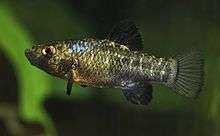
Cyprinodon pupfish typically feed on algae and detritus, but in the two places where several species live together they have diverged into different niches, including the fish-eating C. maya (Lake Chichancanab), zooplankton-eating C. simus (Lake Chichancanab), amphipod- and bivalve-eating C. labiosus and C. verecundus (Lake Chichancanab), scale-eating C. desquamator (San Salvador Island lakes), and ostracod- and gastropod-eating C. brontotheroides (San Salvador Island lakes).[2][19]
Species
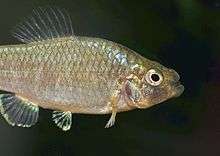

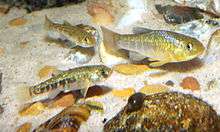
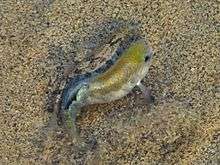
There are currently 49 recognized species in this genus:[1][2]
- Cyprinodon albivelis W. L. Minckley & R. R. Miller, 2002 (Whitefin pupfish)
- Cyprinodon alvarezi R. R. Miller, 1976 (Potosi pupfish)
- †Cyprinodon arcuatus W. L. Minckley & R. R. Miller, 2002 (Santa Cruz pupfish)
- Cyprinodon artifrons C. L. Hubbs, 1936 (Yucatán pupfish)
- Cyprinodon atrorus R. R. Miller, 1968 (Bolson pupfish)
- Cyprinodon beltrani Álvarez, 1949 (Blackfin pupfish)
- Cyprinodon bifasciatus R. R. Miller, 1968 (Cuatro Cienegas pupfish)
- Cyprinodon bobmilleri Lozano-Vilano & Contreras-Balderas, 1999 (San Ignacio pupfish)
- Cyprinodon bondi G. S. Myers, 1935 (Hispaniola pupfish)
- Cyprinodon bovinus S. F. Baird & Girard, 1853 (Leon Springs pupfish)
- Cyprinodon brontotheroides C. H. Martin & Wainwright, 2013 (Durophage pupfish)[2]
- †Cyprinodon ceciliae Lozano-Vilano & Contreras-Balderas, 1993 (Villa Lopez pupfish)
- Cyprinodon dearborni Meek, 1909
- Cyprinodon desquamator C. H. Martin & Wainwright, 2013 (Scale-eating pupfish)[2]
- Cyprinodon diabolis Wales, 1930 (Devil's Hole pupfish)
- Cyprinodon elegans S. F. Baird & Girard, 1853 (Comanche Springs pupfish)
- Cyprinodon eremus R. R. Miller & Fuiman, 1987 (Sonoyta pupfish)
- Cyprinodon esconditus Strecker, 2002 (Hidden pupfish)
- Cyprinodon eximius Girard, 1859 (Conchos pupfish)
- Cyprinodon fontinalis M. L. Smith & R. R. Miller, 1980 (Carbonera pupfish)
- Cyprinodon higuey C. M. Rodriguez & M. L. Smith, 1990 (Black-and-blue Pupfish)
- Cyprinodon hubbsi Carr, 1936 (Lake Eustis minnow)
- †Cyprinodon inmemoriam Lozano-Vilano & Contreras-Balderas, 1993 (Charco Azul pupfish)
- Cyprinodon julimes De la Maza-Benignos & Vela-Valladares, 2009 (Julimes pupfish)
- Cyprinodon labiosus Humphries & R. R. Miller, 1981 (Thicklip pupfish)
- Cyprinodon laciniatus C. L. Hubbs & R. R. Miller, 1942 (Bahama pupfish)
- †Cyprinodon latifasciatus Garman, 1881 (Parras pupfish)
- Cyprinodon longidorsalis Lozano-Vilano & Contreras-Balderas, 1993 (La Palma pupfish)
- Cyprinodon macrolepis R. R. Miller, 1976 (Largescale pupfish)
- Cyprinodon macularius S. F. Baird & Girard, 1853 (Desert pupfish)
- Cyprinodon maya Humphries & R. R. Miller, 1981 (Maya pupfish)
- Cyprinodon meeki R. R. Miller, 1976 (Mezquital pupfish)
- Cyprinodon nazas R. R. Miller, 1976 (Nazas pupfish)
- Cyprinodon nevadensis C. H. Eigenmann & R. S. Eigenmann, 1889
- Cyprinodon nevadensis amargosae R. R. Miller, 1948 (Amargosa River pupfish)
- Cyprinodon nevadensis calidae R. R. Miller, 1948 (Tecopa pupfish)
- Cyprinodon nevadensis mionectes R. R. Miller, 1948 (Ash Meadows pupfish)
- Cyprinodon nevadensis nevadensis C. H. Eigenmann & R. S. Eigenmann, 1889 (Amargosa pupfish)
- Cyprinodon nevadensis pectoralis R. R. Miller, 1948 (Warm Springs pupfish)
- Cyprinodon nevadensis shoshone R. R. Miller, 1948 (Shoshone pupfish)
- Cyprinodon nichollsi M. L. Smith, 1989 (Jaragua pupfish)
- Cyprinodon pachycephalus W. L. Minckley & C. O. Minckley, 1986 (Bighead pupfish)
- Cyprinodon pecosensis A. A. Echelle & A. F. Echelle, 1978 (Pecos pupfish)
- Cyprinodon pisteri R. R. Miller & W. L. Minckley, 2002 (Palomas pupfish)
- Cyprinodon radiosus R. R. Miller, 1948 (Owens pupfish)
- Cyprinodon riverendi (Poey, 1860) (synonym: Cyprinodon jamaicensis, Fowler, 1939)
- Cyprinodon rubrofluviatilis Fowler, 1916 (Red River pupfish)
- Cyprinodon salinus R. R. Miller, 1943
- Cyprinodon salinus milleri LaBounty & Deacon, 1972 (Cottonball marsh pupfish)
- Cyprinodon salinus salinus R. R. Miller, 1943 (Death Valley pupfish, Salt Creek pupfish)
- Cyprinodon salvadori Lozano-Vilano, 2002 (Bocochi pupfish)
- Cyprinodon simus Humphries & R. R. Miller, 1981 (Boxer pupfish)
- Cyprinodon suavium Strecker, 2005
- Cyprinodon tularosa R. R. Miller & A. A. Echelle, 1975 (White Sands pupfish)
- Cyprinodon variegatus (Lacépède, 1803)
- Cyprinodon variegatus baconi Breder, 1932
- Cyprinodon variegatus ovinus (Mitchill, 1815)
- Cyprinodon variegatus variegatus (Lacépède, 1803) (Sheepshead minnow)
- Cyprinodon verecundus Humphries, 1984 (Largefin pupfish)
- Cyprinodon veronicae Lozano-Vilano & Contreras-Balderas, 1993 (Charco Palma pupfish)
References
- 1 2 3 Froese, Rainer, and Daniel Pauly, eds. (2018). Species of Cyprinodon in FishBase. October 2018 version.
- 1 2 3 4 5 6 7 8 Martin, C. H., and P. C. Wainwright (2013). Multiple Fitness Peaks on the Adaptive Landscape Drive Adaptive Radiation in the Wild. Science 339(6116): 208-211.
- 1 2 3 Contreras-Balderas, S.; L. Lozano-Vilano (1996). "Extinction of most Sandia and Potosí valleys (Nuevo León, Mexico) endemic pupfishes, crayfishes and snails". Ichthyol. Explor. Freshwaters. 7 (1): 33–40.
- ↑ Helfman, G.; B.B. Collette; D.E. Facey; B.W. Bowen (2009). The Diversity of Fishes: Biology, Evolution, and Ecology. Wiley-Blackwell. p. 413. ISBN 978-1-4051-2494-2.
- ↑ Contreras Balderas, S., and W. Bussing |(2013). Yucatan. Freshwater Ecoregions of the World. Retrieved 1 March 2013.
- ↑ Strecker, U. (2006). "The impact of invasive fish on an endemic Cyprinodon species flock (Teleostei) from Laguna Chichancanab, Yucatan, Mexico". Ecology of Freshwater Fish. 15 (4): 408–418. doi:10.1111/j.1600-0633.2006.00159.x.
- ↑ Clarke, A. (2017). Principles of Thermal Ecology: Temperature, Energy and Life. Oxford University Press. p. 323. ISBN 978-0-19-955166-8.
- 1 2 Otto, R.G.; S.D. Gerking (1973). "Heat Tolerance of a Death Valley Pupfish (Genus Cyprinodon)". Physiological Zoology. 46 (1): 43–49.
- ↑ Bennett, W.A.; T.L. Beitinger (1997). "Temperature Tolerance of the Sheepshead Minnow, Cyprinodon variegatus". Copeia. 1997 (1): 77–87.
- 1 2 Smith, K. & Darwall, W.R.T. (2013). "Cyprinodon arcuatus". IUCN Red List of Threatened Species. Version 2018.1. International Union for Conservation of Nature. Retrieved 8 October 2018.
- ↑ Contreras-Balderas, S. & Almada-Villela, P. (1996). "Cyprinodon ceciliae". IUCN Red List of Threatened Species. Version 2012.2. International Union for Conservation of Nature. Retrieved 1 March 2013.
- ↑ Contreras-Balderas, S. & Almada-Villela, P. (1996). "Cyprinodon inmemoriam". IUCN Red List of Threatened Species. Version 2012.2. International Union for Conservation of Nature. Retrieved 1 March 2013.
- ↑ Contreras-Balderas, S. & Almada-Villela, P. (1996). "Cyprinodon latifasciatus". IUCN Red List of Threatened Species. Version 2012.2. International Union for Conservation of Nature. Retrieved 1 March 2013.
- ↑ Contreras-Balderas, S. & Almada-Villela, P. (1996). "Cyprinodon spp.". IUCN Red List of Threatened Species. Version 2012.2. International Union for Conservation of Nature. Retrieved 1 March 2013.
- ↑ Contreras-Balderas, S. & Almada-Villela, P. (1996). "Cyprinodon alvarezi". IUCN Red List of Threatened Species. Version 2012.2. International Union for Conservation of Nature. Retrieved 1 March 2013.
- ↑ Contreras-Balderas, S. & Almada-Villela, P. (1996). "Cyprinodon longidorsalis". IUCN Red List of Threatened Species. Version 2012.2. International Union for Conservation of Nature. Retrieved 1 March 2013.
- 1 2 Contreras-MacBeath, T.; M.B. Rodríguez; V. Sorani; C. Goldspink; G.M. Reid (2014). "Richness and endemism of the freshwater fishes of Mexico". Journal of Threatened Taxa. 6 (2): 5421–5433. doi:10.11609/JoTT.o3633.5421-33.
- 1 2 3 Ceballos, G.; E.D. Pardo; L.M Estévez; H.E. Pérez, eds. (2016). Los peces dulceacuícolas de México en peligro de extinción. ISBN 978-607-16-4087-1.
- 1 2 Martin, C.; P.C. Wainwright (2011). "Trophic novelty is linked to exceptional rates of morphological diversification in two adaptive radiations of Cyprinodon pupfish". Evolution. 65 (8): 2197–2212. doi:10.1111/j.1558-5646.2011.01294.x.
- ↑ Martin, C.H.; Crawford, J.E.; Turner, B.J.; Simons, L.H. (2016). "Diabolical survival in Death Valley: recent pupfish colonization, gene flow and genetic assimilation in the smallest species range on earth". Proc Biol Sci. 283 (1823). doi:10.1098/rspb.2015.2334.
- ↑ "Devils Hole Pupfish". U.S. Fish and Wildlife Service. December 2, 2013. Retrieved 7 October 2018.